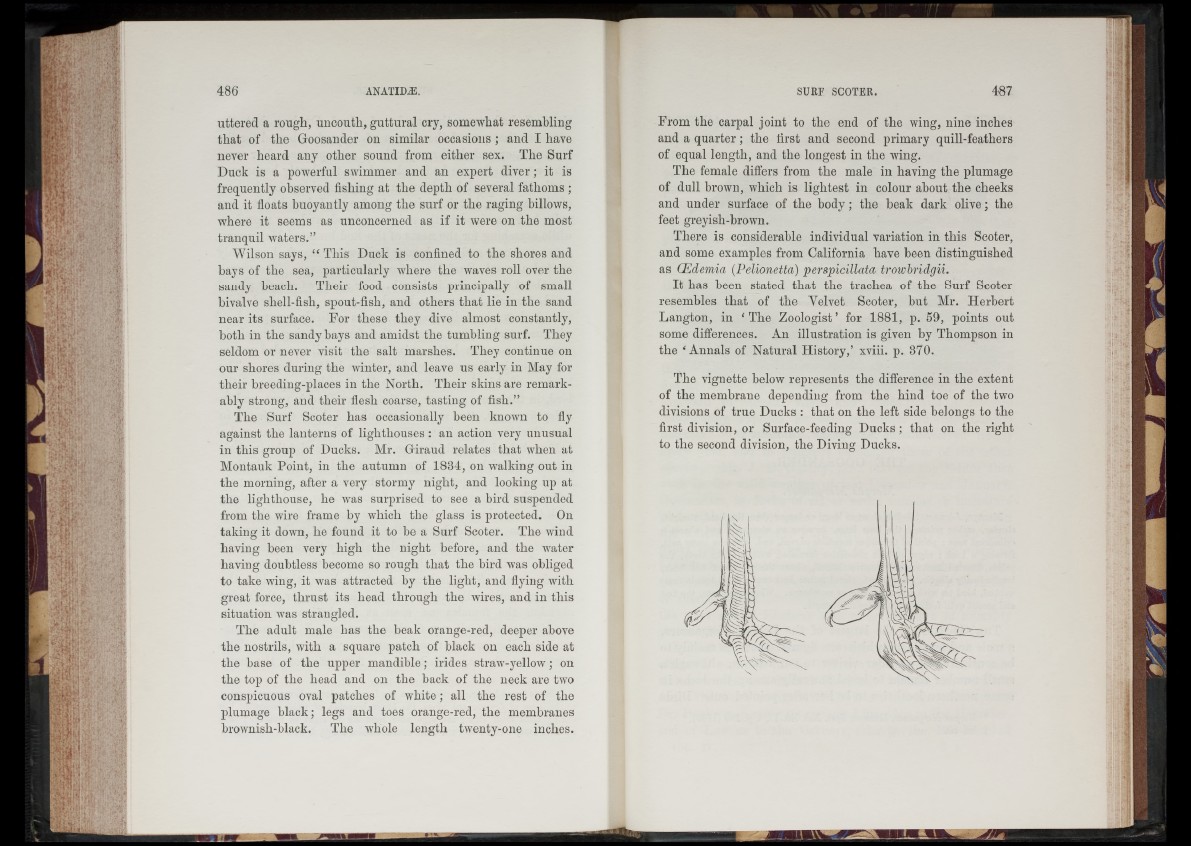
uttered a rough, uncouth, guttural cry, somewhat resembling
that of the Goosander on similar occasions ; and I have
never heard any other sound from either sex. The Surf
Duck is a powerful swimmer and an expert diver; it is
frequently observed fishing at the depth of several fathoms ;
and it floats buoyantly among the surf or the raging billows,
where it seems as unconcerned as if it were on the most
tranquil waters.”
Wilson says, “ This Duck is confined to the shores and
hays of the sea, particularly where the waves roll over the
sandy beach. Their food consists principally of small
bivalve shell-fish, spout-fish, and others that lie in the sand
near its surface. For these they dive almost constantly,
both in the sandy bays and amidst the tumbling surf. They
seldom or never visit the salt marshes. They continue on
our shores during the winter, and leave us early in May for
their breeding-places in the North. Their skins are remarkably
strong, and their flesh coarse, tasting of fish.”
The Surf Scoter has occasionally been known to fly
against the lanterns of lighthouses : an action very unusual
in this group of Ducks. Mr. Giraud relates that when at
Montauk Point, in the autumn of 1884, on walking out in
the morning, after a very stormy night, and looking up at
the lighthouse, he was surprised to see a bird suspended
from the wire frame by which the glass is protected. On
taking it down, lie found it to be a Surf Scoter. The wind
having been very high the night before, and the water
having doubtless become so rough that the bird was obliged
to take wing, it was attracted by the light, and flying with
great force, thrust its head through the wires, and in this
situation was strangled.
The adult male has the beak orange-red, deeper above
the nostrils, with a square patch of black on each side at
the base of the upper mandible; irides straw-yellow ; on
the top of the head and on the back of the neck are two
conspicuous oval patches of white; all the rest of the
plumage black; legs and toes orange-red, the membranes
brownisli-black. The whole length twenty-one inches.
From the carpal joint to the end of the wing, nine inches
and a quarter; the first and second primary quill-feathers
of equal length, and the longest in the wing.
The female differs from the male in having the plumage
of dull brown, which is lightest in colour about the cheeks
and under surface of the body ; the beak dark olive; the
feet greyish-brown.
There is considerable individual variation in this Scoter,
and some examples from California have been distinguished
as (Eclemia (Pelionetta) perspicillata trowbridgii.
It has been stated that the trachea of the Surf Scoter
resembles that of the Velvet Scoter, but Mr. Herbert
Langton, in ‘ The Zoologist’ for 1881, p. 59, points out
some differences. An illustration is given by Thompson in
the ‘Annals of Natural Plistory,’ xviii. p. 370.
I
The vignette below represents the difference in the extent
of the membrane depending from the hind toe of the two
divisions of true Ducks : that on the left side belongs to the
first division, or Surface-feeding Ducks ; that on the right
to the second division, the Diving Ducks.
■
Ü
i | j